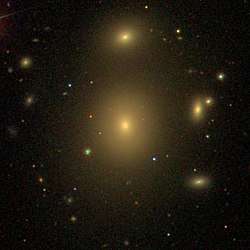NGC 3842
| NGC 3842 | |
|---|---|
 SDSS image of NGC 3842. The small galaxy at the top of the image is NGC 3841. | |
| Observation data (J2000 epoch) | |
| Constellation | Leo |
| Right ascension | 11h 44m 02.2s[1] |
| Declination | 19° 56′ 59.3″[1] |
| Redshift | 0.021068 ± 0.000031[1] |
| Helio radial velocity | 6316 ± 9 km/s[1] |
| Distance | 325 Mly (99.6 Mpc) |
| Group or cluster | Leo Cluster |
| Apparent magnitude (V) | 12.78[1] |
| Characteristics | |
| Type | E[1] |
| Apparent size (V) | 1.4 x 1.0[1] |
| Notable features | brightest member of the Leo Cluster, has a 9.7 billion solar mass black hole |
| Other designations | |
| UGC 6704, PGC 36487, MCG 3-30-72, ZWG 97.95,[1] | |
NGC 3842 is an elliptical galaxy in the constellation of Leo. It was discovered by William Herschel. It is notable for containing one of the largest black holes ever detected, reported to have a mass of 9.7 billion solar masses.[2] It is around 330 million light-years distant from Earth.
NGC 3842 is the brightest member[3] of the Leo Cluster.[4][5]
References
- 1 2 3 4 5 6 7 8 "NASA/IPAC Extragalactic Database". Results for NGC 3842. Retrieved 2011-12-05.
- ↑ Rincon, Paul (2011-12-05). "Team sees biggest black holes yet". bbc.co.uk. Retrieved 2011-12-05.
- ↑ "NGC 3842". Retrieved 2018-04-19.
- ↑ "Are You Ready, Willing, and Abell? - Sky & Telescope". Sky & Telescope. 2017-04-26. Retrieved 2018-04-19.
- ↑ "Record massive black holes discovered lurking in monster galaxies". Berkeley News. 2011-12-05. Retrieved 2018-04-19.
This article is issued from
Wikipedia.
The text is licensed under Creative Commons - Attribution - Sharealike.
Additional terms may apply for the media files.